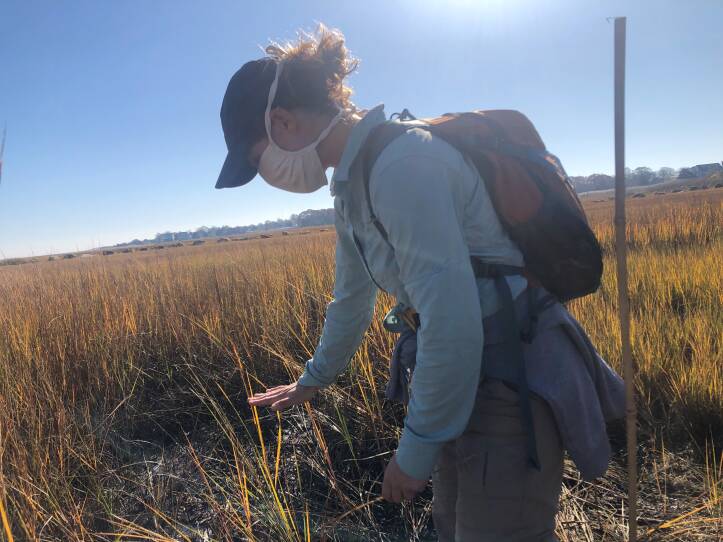Wearing tall rubber boots, a scientist walked along an overgrown path to the Little Bay salt marsh in Fairhaven.
“I'm going to kind of weave us up through this back zone,” said Alice Besterman, the post-doctoral researcher with the Buzzards Bay Coalition.
Besterman pushed past tall, pale grasses that hid crabs underfoot, and when she reached the salt marsh, it was low tide. She should have been standing on a meadow of short, lush grass, but that’s not what surrounded her.
“So you see no grass, unvegetated, sandy mud where all the grass is gone,” she said, pointing to dozens of areas on the marsh. “In some locations, you also see anywhere from one inch to five or six inches of standing water.”
These muddy areas are what scientists call “dieback.”

Increasing high tides are causing water to get stuck on the marsh. That standing water kills the soft grass, leaving big patches of mud.
“As these areas of dieback that hold water expand over time, they essentially start eating the marsh from the inside out,” Besterman explained.
Normally, salt marshes migrate inland—retreating from the sea level rise that’s carving away at the coastline. When marshes are healthy enough to move, they can continue to provide habitat for fish and wildlife, filter pollution from the watershed, and protect nearby homes from flooding.
But now, climate change is making sea levels rise faster than humans have ever seen before, so these dieback areas are growing too quickly for the marshes to retreat and maintain their integrity.
In response, a team of local scientists is looking to buy them time with a new technique called "runneling."
“This is the digging process!” Besterman exclaimed.
Way out on the marsh, she was surrounded by a half-dozen technicians and scientists from the Buzzards Bay Coalition, Save the Bay in Rhode Island, the Bristol County Mosquito Control Commission, and other groups. The team was busy guiding the operator of an excavator.
“This is a low ground pressure excavator,” Besterman said. “It is specially created to work in marshes.”
It’s a surprisingly delicate procedure for a massive piece of machinery.
The operator scratched out grooves in the mud that the scientists call “runnels,” just three to four inches deep. The long, shallow channels allow water to drain from the middle of the marsh into Little Bay.
“The technique is to help aid tidal flow to get that standing surface water off of these areas of dieback, allow the tide to come in and out, allow vegetation to regrow in these bare, muddy areas, and to start restoring -- hopefully -- other ecosystem services, as well,” Besterman said.

This technique has already been applied alongside Narragansett Bay in Rhode Island, where healthy marsh plants like pickleweeds have returned to areas of dieback after just one growing season.
On a planetary scale, salt marshes decrease the effects of global warming by capturing carbon in the atmosphere. They sequester greenhouse gases at a much faster rate than forests.
Plus, salt marshes keep a check on unwanted species.
“A species that thrives in these conditions of degrading habitat and especially these shallow, smaller pockets of standing water are mosquitoes,” said Wenley Ferguson, director of habitat restoration at Save the Bay.
By reducing the standing water on the marsh, she said, the team will eliminate mosquito breeding habitats. That could decrease the deadly mosquito-borne illness, known as EEE.
“The runnels -- these shallow creeks -- are also providing a way for fish species called mummichogs in the salt marsh … that will feed on mosquito larvae,” she said.
Runnelling is still a new technique, and while it shows promise, these scientists are racing the clock.
In the Northeast, sea levels are rising faster than just about anywhere in the world, and soon it could be too late to restore the marsh. With that in mind, the scientists will spend the next two to three years documenting exactly how well the runnels perform, collecting hundreds of thousands of data points.
Restoration will be a long process, but sometimes, the work is rewarded almost immediately.
As the excavator rumbled nearby, Ferguson peered down into one of the new runnels.
“The fish have already cleared the creek,” she said. “I just saw a whole slew of them. Those are probably Mummichogs. … And they were not here this morning … but now that that water is flowing out and giving a way for the fish to move in, that's encouraging to see a response in an hour.”
Ferguson and her crew smiled behind their masks. Then they crossed the marsh, to dig another runnel.





